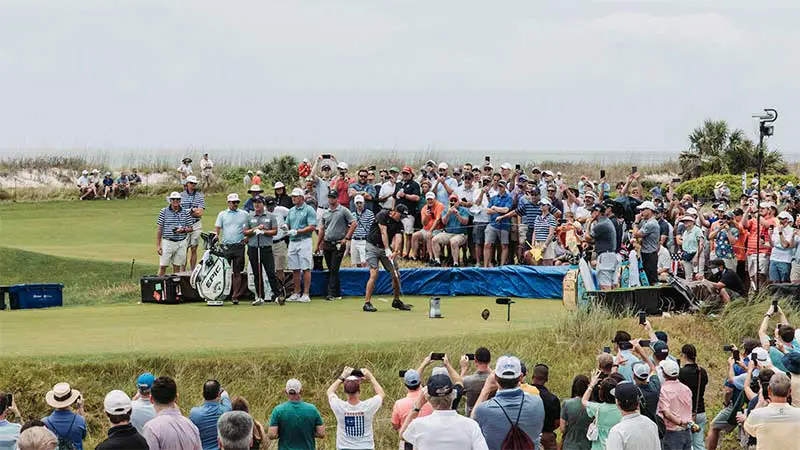Golf, a sport celebrated for its precision and endurance, showcases tournaments that capture the essence of competition and camaraderie. As enthusiasts delve into the world of golf, a common query surfaces: “How long does a golf tournament last?”
In this exploration, we embark on a journey through the intricacies of golf events, uncovering the factors that influence their duration. If you want to know the length of different tournaments and the longest games in the history, this article is for you.
From the prestigious majors to local competitions, the timeline of a golf tournament is a carefully orchestrated dance between players, courses, and the timeless traditions that define the sport.
Join us as we unravel the tapestry of time in the realm of golf, gaining insights into the captivating rhythm that dictates the length of these tournaments.
How Long Does A Golf Tournament Last?
Golf tournaments, renowned for their strategic gameplay and scenic courses, vary in duration based on factors ranging from the tournament format to the number of players.
The time frame for a golf tournament is not a one-size-fits-all scenario but a nuanced blend of tradition, competition, and logistical considerations.
Tournament Formats and Their Impact
The format of a golf tournament plays a pivotal role in determining its duration. Different formats, such as stroke play, match play, or a combination of both, can significantly influence how long an event lasts.
Stroke Play
In stroke play tournaments, each golfer aims to complete the course in the fewest strokes over one or more rounds. The number of rounds can vary, with most professional tournaments typically consisting of four rounds (72 holes).
The pace of play and the competitiveness of the field contribute to the overall duration.
Match Play
Match play tournaments involve head-to-head competition between individual golfers or teams. The number of holes played in each match can vary, impacting the total time required for the tournament.
Unlike stroke play, where every stroke counts, match play focuses on winning individual holes.
Combination Formats
Some tournaments feature a combination of stroke play and match play, adding an extra layer of complexity to the schedule. The integration of different formats can result in a dynamic and varied experience for players and spectators alike.
Professional vs. Amateur Tournaments
Professional and amateur tournaments also exhibit differences in duration, influenced by factors such as the number of participants, course setup, and overall event logistics.
Professional Tournaments
Prestigious professional tournaments, like the majors (Masters, U.S. Open, The Open Championship, and PGA Championship), typically span four days.
The top players in the world compete over 72 holes, navigating challenging courses with varying conditions. Playoff scenarios, if required, can extend the event beyond the scheduled duration.
Amateur Tournaments
Amateur tournaments vary widely in duration, ranging from single-day events to multi-day competitions. Factors such as the level of the tournament, course difficulty, and the number of entrants contribute to the time commitment for participants.
External Factors Influencing Duration
Apart from the inherent characteristics of the tournament, external factors can impact its duration:
Weather Conditions
Adverse weather, such as rain delays or inclement conditions, can disrupt the tournament schedule, leading to extensions or adjustments.
Course Layout and Difficulty
The design and difficulty of the golf course play a crucial role in how long it takes to complete a round. Courses with challenging layouts and tougher conditions may contribute to longer playing times.
Pace of Play Initiatives
Golf organizations often implement pace of play initiatives to maintain a reasonable speed of play during tournaments. Penalties or warnings may be issued to players or groups not adhering to established pace of play guidelines.
Playoff Scenarios
In the event of tied scores at the conclusion of the scheduled rounds, playoffs become necessary to determine the winner. Playoffs can add extra holes or even an additional day to the tournament, extending its overall duration.
Balancing Tradition and Viewer Experience
While tradition and the integrity of the game are paramount, organizers also consider the viewer experience. Striking a balance between maintaining the essence of golf and catering to modern attention spans is an ongoing challenge.
Television broadcasts, sponsor commitments, and fan engagement contribute to the evolving landscape of golf tournament durations.
What Are the Longest Golf Tournaments in History?

The history of golf is dotted with tournaments that have tested the endurance and skill of players, sometimes spanning extraordinary lengths of time.
These marathons, often influenced by unique circumstances, weather conditions, or tournament formats, stand as testaments to the resilience and determination of golfers. Let’s delve into the stories of some of the longest golf tournaments in history.
1930 Argentine Open
The Argentine Open in 1930 holds the record for the longest golf tournament in terms of duration. The tournament, played at the Jockey Club in Buenos Aires, unfolded over an astounding 72 holes—spread across eight days.
Adverse weather conditions, including heavy rain, forced repeated suspensions, making it a true test of patience for the competitors. Ultimately, the event concluded with a new champion, José Jurado, who emerged victorious after enduring the prolonged challenges.
2005 LPGA Takefuji Classic
In the realm of women’s golf, the 2005 LPGA Takefuji Classic stands out as one of the longest tournaments in terms of holes played. The event, held at the Las Vegas Country Club, saw a remarkable 108 holes of golf.
Due to weather delays, the tournament extended into Monday, requiring players to navigate the course for six rounds instead of the typical four. Mexican golfer Lorena Ochoa emerged as the victor in this marathon competition.
1947 Chicago Victory National Open
The Chicago Victory National Open in 1947 holds a unique place in golf history for its extended duration. Played at the Tam O’Shanter Country Club, this tournament lasted for a staggering 72 holes over five days.
Ben Hogan, a legendary figure in golf, secured victory after enduring the challenges posed by the extended play.
2000 Ricoh Women’s British Open
The 2000 Ricoh Women’s British Open, held at the Royal Birkdale Golf Club, was marked by adverse weather conditions that led to a prolonged event.
Heavy rain and high winds resulted in the suspension of play, and the tournament extended into a sixth day. Karrie Webb emerged as the champion after navigating the challenging course and unpredictable weather.
2017 Zurich Classic of New Orleans
While most professional golf tournaments follow a stroke play format, the 2017 Zurich Classic of New Orleans experimented with a team-based format. The tournament, played at TPC Louisiana, featured 80 two-player teams competing in a 72-hole stroke play format.
The unique structure, coupled with weather delays, resulted in an extended schedule, providing fans with an entertaining and unconventional golf experience.
1974 Portuguese Open
The 1974 Portuguese Open witnessed an extraordinary event that stretched the boundaries of golf tournament duration. The tournament, held at the Penina Golf Club, initially featured 72 holes of play.
However, a tie between Manuel Ballesteros and Brian Huggett prompted a sudden-death playoff that extended for an astonishing 11 holes. Ultimately, Ballesteros secured victory in what remains one of the longest playoffs in professional golf history.
1963 Phoenix Open
The 1963 Phoenix Open stands out for the endurance displayed by the participants. Due to frost delays and weather interruptions, the tournament extended into a sixth day.
Jack Nicklaus, one of the greatest golfers of all time, emerged victorious in this extended competition, showcasing his ability to navigate challenges both on and off the course.
1920 U.S. Open
The 1920 U.S. Open, held at the Inverness Club in Toledo, Ohio, is remembered for its unique format and extended play. The tournament featured a staggering 144 holes, with 36 holes played each day over four consecutive days.
Scottish golfer George Duncan emerged as the champion after navigating the demanding course and enduring the physical and mental demands of the extended format.
These tales of prolonged golf tournaments offer a glimpse into the resilience, skill, and adaptability of golfers when faced with unique challenges.
FAQs
How long does a typical professional golf tournament last?
Professional golf tournaments usually span four days, with players completing 18 holes per day. The standard format includes 72 holes, determining the winner based on cumulative strokes.
What factors can influence the duration of a golf tournament?
Several factors impact tournament duration, including the format (stroke play, match play), weather conditions, course layout, and the number of players. Playoff scenarios or weather delays may extend the scheduled timeframe.
Are there variations in the duration of amateur golf tournaments?
Yes, amateur golf tournaments can vary widely in duration. Local events might span a day or two, while larger competitions may extend over several days. The duration depends on factors such as the tournament level and the number of participants.
How do playoffs contribute to the length of a golf tournament?
Playoffs occur when players tie at the end of scheduled rounds. Extra holes are played until a winner emerges. Playoffs can add a few additional holes or, in some cases, a whole extra day to the tournament.
Has the length of golf tournaments changed over the years?
While the standard duration of professional tournaments remains four days, the golfing landscape has seen experimentation with formats, such as team events and unique tournament structures.
Adverse weather conditions can still lead to variations in schedule, affecting the overall length of events.
Conclusion
The duration of a golf tournament is not merely a ticking clock but a symphony of elements harmonizing on the fairways. From the strategic layout of courses to the resilience of players facing diverse challenges, each event weaves a unique tale.
As we close the chapter on our exploration, we find that the temporal tapestry of golf tournaments is a reflection of the sport’s multifaceted nature.
Whether it be the nail-biting tension of a sudden-death playoff or the leisurely pace of a relaxed exhibition, the time spent on the course is a testament to the enduring allure of golf.
So, the next time you find yourself wondering about the duration of a golf tournament, remember, it’s not just about counting hours; it’s about savoring the moments that make this sport a timeless pursuit. Enjoy your game with the newfound knowledge!








Colin McCarthy